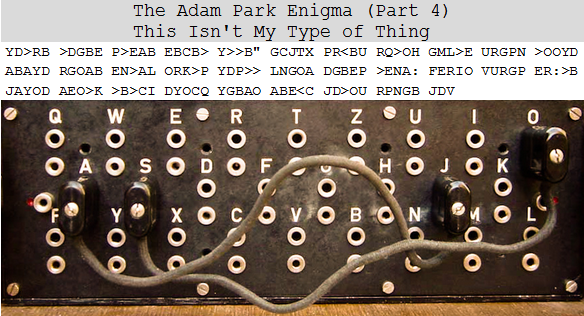The other caches in the series:
Part 1: The Confounding Compounds
Part 2: When Will My Reflection Show?
Part 3: You Need To Be More Flexible!
Part 4: This Isn’t My Type of Thing
Part 5: “…the Things No One Can Imagine”
Introduction to TAPE
The Adam Park Enigma (TAPE) is a series of 5 mystery caches placed around the Adam Park residential estate. 4 of the caches (Parts 1 – 4) are ordinary mystery caches where you have to solve a puzzle to find the coordinates of the final cache. The puzzle for Part 5 is requires information placed in the first four caches, so you will need to complete the first four caches before you can attempt Part 5.
Each part of the series contains a write-up of the history of the area and a description of the Enigma cipher, which is the code that needs to be cracked to obtain the final cache in the series. You will find the puzzle that you need to solve for this part of TAPE near the end of the listing
The History of Adam Park (Part 4)
At 4:00 pm on the 15th February 1942, the British surrendered Singapore to the Japanese, and the fighting at Adam Park ended. The soldiers, who had spent the last few days entrenched in the houses and the gardens surrounding them also surrendered. They stepped out under a white flag and surrendered to the Japanese on Adam Road. All of the surviving British soldiers were rounded up at a tennis court, and made to march to Changi as Prisoners-of-war.
It was not long after that, though, that a few thousand POWs were sent back to the houses of Adam Park as a new POW camp was set up in the Sime Road area. The soldiers were put to work building Syonan Jinja, a Shinto Shrine dedicated to the fallen Japanese soldiers by the banks of the nearby MacRitchie Reservoir.

While the POW were still cramped in the houses (a couple of hundred of POWs were stuffed into each), the camp still had the basic amenities and sufficient rations. A chapel, a clinic and even a theatre was set up for the POWs. Their living conditions were not as poor as those in Changi, but yet, they still suffered lashings and beatings from the Japanese commanders as they set about their daily tasks. The POWs had also built a chapel in one of the houses, and were reported to have painted murals, just like the murals that were found in Changi Chapel.
Much of the war-time history and remnants of the Adam Park area have been covered up as the residents have moved back into the houses and rebuilt… but, work is underway to recover much of Adam Park’s forgotten history.
The Enigma Cipher (Part 4)
Back in the United Kingdom, the “boffins” of Bletchley Park, under the lead of Alan Turing were on the verge of cracking the Enigma cipher. The cryptographic flaw (that no letter can be encrypted to itself) could be exploited by allowing intelligent guesses on a small fragment of the message that the Germans were sending. For instance: if QTBGTEZUUI cannot be ATTACKYORK, since the first T cannot become a T again. However, one could guess it to be HEILHITLER since all the letters have changed in this case. With this information, the relationship between the 10 letters with another 10 can be established. Another example (for "Keine besonderen Ereignisse" [trans: nothing to report]) is shown below:

Furthermore, all the circuitry of the Enigma machine is known (as the British had the machine in their hands), and so, the translation can be made if enough settings can be tested out quickly. What Turing and the boffins had to do was simply reverse engineer the settings based on the fact that Q = H, T = E and so on for consecutive rotor positions in a quick manner. However, there are still far too many settings to try out.
The next spark of Turing’s ingenuity was expressed when he realised that the plug board can only map one letter to another (e.g. A to a C, and C to A) and nothing else. This was a truly important discovery because this meant that when they test the earlier established mapping (Q = H, T = E) on a given setting (plug C to plug A), if there is a contradiction of this guess (such as A to D, or C to F) when simulating the decoding all settings combinations containing “plug A to plug C” can be eliminated, hugely reducing the number of settings to try out.
Since we are on the topic of the plug settings, here’s the puzzle for the cache that will provide the Steckerverbindugen for the final TAPE cipher.
TAPE Puzzle Part 4: This Isn’t My Type of Thing
While researching on the plug board settings for the TAPE puzzles, I decided that I had to be more efficient. I mean, I have plenty of other things to complete, but even after midnight on some days, I’m still writing out listings and creating the images I need. So, I decided to experiment with a setting that I was told will speed things up a little… and everything went downdcnn uprm yd.p.v Rd e.apw dr, am C ircbi yr ick. frg yd. jrrpeo br,Z Rd ,.nnw d.p. cy co abf,afS:

You can check your answer here:
